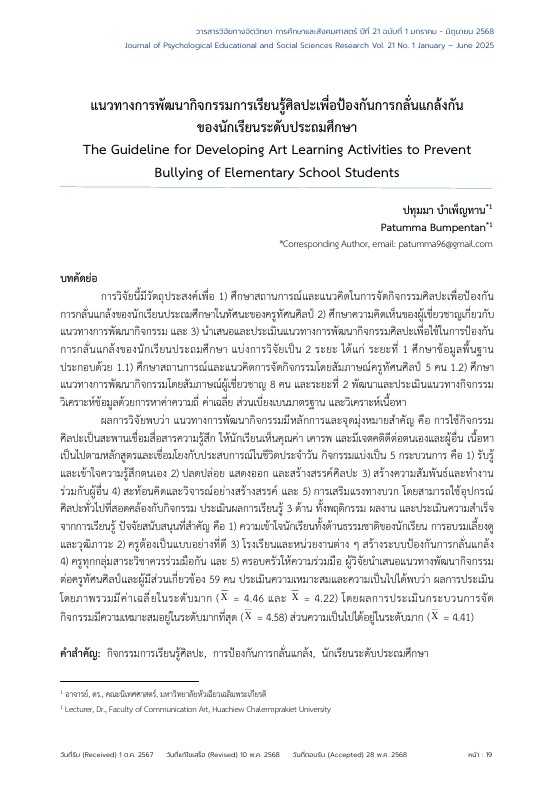แนวทางการพัฒนากิจกรรมการเรียนรู้ศิลปะเพื่อป้องกันการกลั่นแกล้งกัน ของนักเรียนระดับประถมศึกษา
The Guideline for Developing Art Learning Activities to Prevent Bullying of Elementary School Students
Keywords:
Art Learning Activities, Bullying Prevention, Elementary School Students, กิจกรรมการเรียนรู้ศิลปะ, การป้องกันการกลั่นแกล้ง, นักเรียนระดับประถมศึกษาAbstract
The research aimed to 1) examine the current situation and conceptual approaches to organize art activities to prevent bullying among primary school students from the perspectives of visual arts teachers, 2) explore expert opinions on the development of art activities, and 3) present and evaluate the proposed art-based activity guidelines designed to prevent bullying among primary students. The study was divided into two phases. Phase 1 involved foundational data collection, aimed to: 1.1) investigate the current situation and concepts through interviews with five visual arts teachers, and 1.2) examine developmental guidelines through interviews with eight experts. Phase 2 focused on developing and evaluating the proposed activity guidelines. Data were analyzed using frequency, mean, standard deviation, and content analysis.
The findings revealed that the core principles and objectives of the proposed activity guidelines emphasized the use of art as a medium for emotional expression and communication. The activities aimed to foster self-worth, mutual respect, and positive attitudes among students. The content aligned with the national curriculum and was integrated with students’ daily life experiences. The activities were structured into five key processes: 1) Recognition: observing and understanding one’s own emotions, 2) Release: expressing and creating through art, 3) Relationship: building connections and collaborating with others, 4) Reflection: engaging in self-reflection and constructive critique, and 5) Reinforcement: strengthening positive behaviors. General art materials appropriate to each activity could be used. Learning outcomes were assessed in three domains: behavioral changes, art products, and individual learning achievements. Key supporting factors for effective implementation included 1) a deep understanding of students’ nature, upbringing, and developmental stages; 2) the teacher serving as a positive role model; 3) school-wide and inter-agency systems for bullying prevention; 4) collaboration among teachers across all subject areas; and 5) active involvement of families. The proposed guidelines were presented to 59 visual arts teachers and stakeholders. The evaluation results indicated a high level of overall suitability (Mean = 4.46) and feasibility (Mean = 4.22), with the activity processes rated as most appropriate (Mean = 4.58) and feasibility rated at a high level (Mean = 4.41).

Downloads
Published
Issue
Section
License
Copyright (c) 2025 วารสารวิจัยทางจิตวิทยา การศึกษาและสังคมศาสตร์ (Journal of Psychological Educational and Social Sciences Research)

This work is licensed under a Creative Commons Attribution-NonCommercial-NoDerivatives 4.0 International License.


